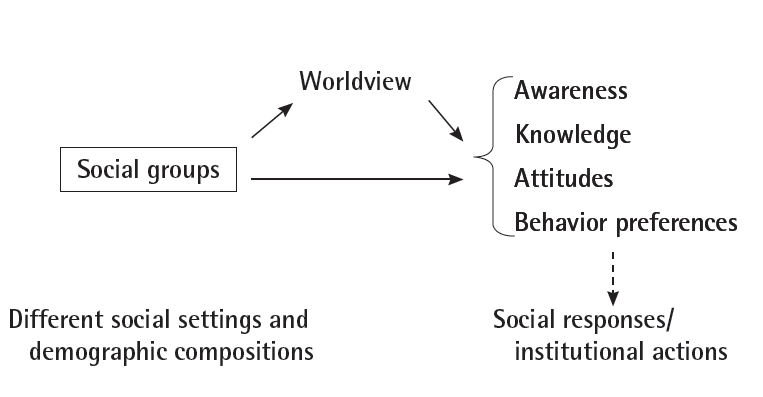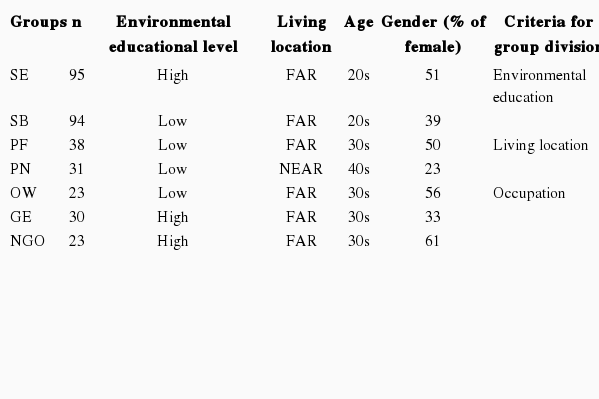Risk and culture: variations in dioxin risk perceptions, behavioral preferences among social groups in South Korea
Article information
Abstract
Objectives
This study examined variations in the perceptions of dioxin risk among social groups defined by geographical living location, environmental education, and occupation. Dioxin risk perceptions were analyzed according to values, risk awareness, knowledge, and behavioral preferences.
Methods
A quasi-experimental survey was designed and conducted on individuals from seven experimental groups in Jeonju city, South Korea, including: people living near incineration facilities; people living far from incineration facilities; governmental experts; nongovernmental organization members; office workers in developmental institutes or banks; students who were enrolled in environmental-related classes; and students who were enrolled in business-related classes.
Results
The results show variations among groups in values, awareness and behavioral preferences. Particular attention should be given to the result that groups with higher connectedness- to-nature values show higher willingness-to-act (WTA) for risk reduction. Result s can be summarized as follows. First, awareness is associated with one’s geographical setting. Second, values and WTA behaviors are related to one’s environmental-related education and occupation. Third, values are significantly related to WTA behaviors.
Conclusions
Different cultures, in terms of values or worldview, among groups influence their perceptions of dioxin risk and choices of risk reduction behaviors. It is important to consider values in communicating complicated long-term risk management involving public participation. Further research should be continuously conducted on the effects of multiple dimensions of values on one’s WTA for risk reduction behaviors.
Introduction
Researchers have examined various factors, in terms of social as well as cultural variables, within different ethnic backgrounds, that influence the variability of risk perceptions and judgments [1,2]. Although South Korea has a single indigenous ethnic group, the variations among sub-cultural or social groups within the country exist in values or worldview [3,4]. Literature has identified shared experience, values, and belief that influence subjective risk perceptions within groups [5]. This study examined variations among different social group in values, dioxin risk awareness, knowledge, and behavioral preferences. Figure 1 illustrates the research framework which conceptualizes interrelationships among social settings, values, and risk perceptions among different social groups.
According to the framework, the hypotheses developed are as follows:
1. There are differences among social groups in values, awareness, knowledge, and behavioral preferences (willingness-to-act [WTA] for risk reduction behaviors) in relation to dioxin risk.
2. There are factors within group variations influencing dioxin risk reduction behaviors.
Seven social groups for the experiment in the city of Jeonju, South Korea were selected and defined according to the following external criteria: living location, occupation association, and environmental education relation. The term ‘social groups’ is a concept comprising both ‘social stations’ from Kasperson’s terminology and ‘stakeholders’. The term ‘social station’ includes the broad concept of individuals who act not only out of personal values but also in role-related or institutional settings [6]. The term stakeholder is defined as “anyone who has an interest in an issue, or anyone who shares the burden of the risk of a wrong decision [7].” A quasi-experimental survey method was designed and conducted for examining variations among the selected groups.
The findings from statistical tests, the analysis of variance (ANOVA) and mean variations provide multiple implications regarding cross-social or cross-cultural differences in risk perceptions and behavioral preferences. This research has theoretical significance in environmental risk and culture. In addition, the results and the developed framework provide practical significance in many related areas such as environmental policy, environmental education, and risk communication.
Literature Review
Historically, dioxins have been controversial chemicals due to their multiple sources (omnipresence) and long-term impact on environmental systems and human health. Park [8] conducted a content analysis of the Korean media for sources of dioxin risk information, and found that mass media had portrayed the multifaceted nature of the risk: 1) various potential sources and paths from release to exposure in our culture and nature, such as, a wasteful life style, take-out culture, dietary behaviors, disposable plastic materials, waste burning processes, manufacturing processes of certain products, fatty foods, and ecosystems; 2) chronic diseases such as cancer risk [9] and non-cancer risks (endocrine, reproductive, and developmental effects) [10]. Difficulties and complexities in dealing with dioxin risks come from scientific uncertainties, subjective variations in individual sensitivity, a wide range of sources and impacts, bioaccumulation in fatty tissues and so on. In order to deal with these complicated risks, it is important to understand the ‘risk communication’ framework which involves the risk perceptions of multiple actors, public involvement in risk management processes, and multimedia risk assessment.
Researchers have argued that individuals from different social groups have various interpretations and decision-making processes when they are exposed to certain risk events or associated information [11]. Various factors have been examined in relation to different risk perceptions: cultural contexts (e.g., values, beliefs, and worldview) [12,13]; psychological factors (e.g., knowledge, affect, experiences, and risk characteristics) [14]; and socioeconomic status, demographics, and/or group affiliation (e.g., social contexts).
Cross-cultural risk research provides valuable insights in terms of the convergent as well as divergent views across society or culture in response to risk and the information emerging from science and technology. The comparative groups can be defined based on specific societal, professional, and cultural orientation. Those groups, in turn, show variations in the subjective risk perception, evaluation, judgment, and behavior [15]. The socio-cultural elements can be accounted for by, or interrelated with the group members’ residential setting, occupational setting, educational level, and socioeconomic variables [16].
Jackson et al. [17] insisted that the cultural theory might possibly bridge the sociological and psychological gaps in risk perception research. Taylor-Gooby & Zinn [18] presented the social amplification of risk framework (SARF) as one possible methodological direction for this linkage. A key part of SARF is communication processes and behavioral responses, which interact with a wide range of social, psychological, institutional, and cultural backgrounds. The range of social backgrounds (or social stations) in SARF makes it possible to examine individuals, social groups, and institutions (e.g., scientists and scientific institutions, journalists and mass media, politicians and governmental agencies, citizens and civic groups). From this perspective, Park & Smardon [19] asserted the importance of the role of worldview as a connection between social elements and psychological factors. In particular, they focused on the influence of worldview on media representation and presented the ways in which one’s worldview examined by social psychology or self-concepts influence the framing of scientific information like dioxin risk information that the Korean media has portrayed. In line with this theoretical foundation, this study examines parts of subjective risk perceptions of multiple actors who have been exposed to the risk information diffused in society as well as the risk events in the local areas of technical sources such as incineration facilities. Particular attention should be given to the theoretical significance of SARF albeit a lack of its analytical power. In this regard, this study would have significance for SARF by enhancing its practical aspects.
Cross-cultural examinations could be conducted both between and within countries [20]. In examining variability of risk perceptions between groups within a country, the outcomes of Rohrmann’s research [12] elucidated the crucial role of sociopsychological factors in the risk evaluation process. The research settings were among societal groups (people with a “technological,” “monetarian,” “ecological” or “feminist” orientation) and across countries (Germany, New Zealand, and Australia). There is much research that shows the divergences of risk appraisals: between experts and lay people [21]; between nations [22]; and among various individuals and social groups [23].
Literature has been conducted on subjective risk perceptions over the Korean population. Chang et al. [24] examined risk perceptions between the general public and experts with individuals from Seoul, South Korea and found that the general public ranked dioxin risks significantly higher than experts. Park et al. [4] identified knowledge, gender, and experience of environmental pollution as the factors influencing risk perception. Cha [25] conducted a psychometric study of risk perceptions of nuclear power in Youngkwang, where a nuclear power plant is located. She provided similar results to existing literature: respondents’ risk perception is significantly related to their knowledge, working experience, perception of the need for nuclear energy, and credibility of information sources.
Within the framework of cross-cultural risk perception, this study examined how different social groups defined by occupation, education, and living location show variations in their risk perceptions and behavioral choices in response to the risk of dioxins. Western democratic industrial societies have experienced the public’s undesirable behaviors over environmental facilities, such as, not in my backyard (NIMBY) or locally-unwanted-landuse (LULU) [26,27] and have tried to identify factors influencing such public behaviors [28-30]. These studies have shown that different perceptions of risk between experts and the public are likely to lead to NIMBY or LULU. However, Korean researchers, Jeong & Lee [31] regarded NIMBY positively, as a precautionary environmental movement which leads to desirable social movements and appropriate governmental actions based on their reduce/reuse/recycle policy. It is interesting to note that the NIMBY phenomena is likely to be defined as culturally different. In addition, it is meaningful to examine a variety of risk perceptions within non-Western societies, such as South Korea, and their responses and behaviors to dioxin risk which arise from such unwanted facilities.
Materials and Methods
This present research was designed to conduct psychometric analysis on individual units as a quasi-experimental survey type [32]: a quantitative method was developed based on qualitative interpretations. In order to examine variations between social groups in the perceptions and opinions of dioxin risk, experimental groups were purposively selected and qualitatively defined. In addition to the purposive sampling method [33], data was strategically gathered through snowball, or chain, sampling methods. The questionnaire was developed based on qualitative interpretations in order to increase more validity. In the following subsections, we explore social groups, survey administration, and the measures used for the research.
Social Groups
In line with the survey design, it is necessary to point out that the selection of social groups embraced logical considerations which inherently pertained to factors of respondents’ living location and their professional and educational situations. Each social group represented individuals who were, to some extent, directly or indirectly interested in risk issues and were involved in management behaviors. This group setting worked as a factor that influenced subjective differences in perceptions and behavioral choices. Therefore, it is necessary to understand the definition and social settings of each social group (see section Analysis and Social Settings).
The selection of social groups in this research was based on the sensitivity of place-related risk exposure and information exposure: geographical living location, occupational association, and environmental education relation. The geographical factor was applied to define the following two groups: people living near incineration facilities (PN) vs. people living far from incineration facilities (PF). The occupation-related factor explored the following three groups: 1) two groups of institutional actors who were involved in environmental issues, including governmental experts (GE) and members of non-governmental organizations (NGO); 2) a group of institutional actors who were occupationally engaged in business or development-related institutes, or business-related office worker (OW). Two college student groups were defined according to environmental education relation: students who were enrolled in environment-related classes (SE) vs. students who were enrolled in business-related classes (SB).
The judgment criteria took account of the following latent meanings: 1) the potential degree to which one is directly exposed to dioxins; 2) the degree to which one is likely to be exposed to risk information through educational channels. That is, it could be assumed that the PN group is likely to be exposed to dioxin risk from operating incinerators than the PF group, and that the GE, NGO, and SE groups have more chance of being exposed to information about dioxin risk than the OW and SB groups. Underlying the effects of the criteria, this research focuses on the effect of one’s values and one’s information exposure on the variations between groups in their attitudes and behavioral preferences against the risk of dioxins.
Survey Administration
The survey was conducted beginning in early June 2005 and completed in late July 2005. The survey was administered as “inperson” or “face-to-face” interviews, not by mail, and was mostly filled out by respondents themselves. Thus, most questionnaires were returned to the survey conductors immediately after respondents completed the survey. This type of survey administration is used in cases where researchers are able to directly approach available groups or populations. In a quasi-experimental research design with purposeful sampling methods, an interviewer- administered protocol is more appropriate, rather than a self-administered protocol, since experimental groups are initially defined. In addition, if the questionnaire is lengthy, an interviewer- administered in-person survey would be expected to obtain low refusal rates or statistically significant response rates within limited time and budget. Only a few respondents (three seniors) verbally responded to each question as survey conductors read out the questions.
For the sampling of the PN group, survey conductors approached residents living near a large-scale waste treatment and incineration facility and asked them to fill out the questionnaire. Thirty-one questionnaires were completed in the PN group. The survey administration for the PF group was conducted in the Kumho Apt. and the Han-Yang Family Clinic in Jeonju city. The apartment complex is located in a densely populated residential area. Considering the size and district, it is possible to consider that the residents living in these apartments belong to middle or high income groups. The questionnaires for the PF were collected from 38 individuals.
For the two student groups (SE and SB), an in-class survey was conducted in environment-related classes (e.g., environmental engineering and environmental science) and businessrelated classes (e.g., game theory and welfare economics) at Cheonbuk National University. Ninety-five students from the department of environmental engineering participated in the survey, while 94 students participated from the departments of economics and accounting.
Twenty-three questionnaires were completed by OW, 30 from GE, and 23 from NGO members. For the OW group, survey administration was conducted using social networking with the people who were working at Jeonbuk Bank or at the Jeonbuk Development Institute. For the GE group, questionnaires were gathered at the Regional Environmental Office in Jeonju. The governmental officials included administrative members and environmental analysts. Twenty-three questionnaires were filled out by members of the Consumer Information Center, Local Agenda 21 (Jeonju, Jeollabuk-do) and the Korean Federation for Environmental Movement. The total number of survey respondents was 334.
Measures
The measures for the research included awareness, knowledge, and WTA for reducing dioxin risk, and values measured by the connectedness-to-nature scale (CNS) [34]. Dioxin risk awareness was a single item identified by asking whether or not respondents had heard of dioxins and their associated risk. For the respondents who answered ‘yes’ on dioxin awareness, a knowledge question was given which instructed respondents to “place a check next to each of the following items that you were already aware of”. The measure of knowledge included 12 items with dichotomous scales based on media representations as well as scientific information (Table S1).
As for the measure of values, the research employed the CNS from social psychological literature. Mayer & Frantz [34] developed the CNS measure designed from Leopold [35] contentions that people need to feel they are part of the broader natural world. The structure of the CNS contains 14 items and a 5-point Likert scale. The original order of the scale was changed from negative (strongly disagree) to positive (strongly agree) in the English version, to read from positive (strongly agree) to negative (strongly disagree) in the Korean version. The format was changed to asking respondents to check boxes for their agreement level, rather than writing numbers on a scale as Korean people are more familiar with this method.
Multiple behaviors in response to the risk of dioxins were observed in Korean society. The variable WTA refers to the intentions of behaviors against the risks, which can be a strong measure of individual actions. The WTA scale has been modified from contingent valuation methods. The methods provide hypothetical situations that are more flexible to accommodate for the variations in individual conditions. Although the WTA does not directly measure one’s actions, it is reliable to use this technique, since the measure allows contingency of behavioral choices.
This research identifies three dimensions in the measure of WTA by levels of risk and risk-related actions (Table S2). REDUCE/ REUSE is explored by one’s willingness to reduce societal- level risk with less contributing of their own resources, time or money. CONTRIBUTION contains one’s willingness to reduce societal-level risk with more contributing of their personal time or money. HEALTH embraces one’s willingness to reduce one’s own individual-level risk. Societal-level risk behaviors do not exclude benefits for others while they conduct the behaviors. By contrast, individual-level risk does exclude benefits for others while they conduct the behaviors.
Analysis and Social Settings
One-way ANOVA, mean (or percentage) distributions, and cross-tabulation (Chi-square) were used for the analysis of the statistical data. For measuring the levels of knowledge and WTA, using dichotomous scales, we recorded the scales as: 0=not checked the items; 1= checked the items. For the analysis of the 5-point Likert scale for connectedness-to-nature values, we used a raw score scale (strongly agree at 1 and strongly disagree at 5) except for three negative items. Those negative items were scored in reverse (strongly agree at 5 and strongly disagree at 1). The negative items included #4, #12, and #14, stated as: I often feel disconnected from nature; when I think of my place on Earth, I consider myself to be a top member of a hierarchy that exists in nature; my personal welfare is independent of the welfare of the natural world (Table S1). The lower the score, the higher the CNS values, and vice versa. Reliability analysis of the CNS showed the internal consistency of all 14 items was high, alpha=0.81.
The survey questionnaire included yes/no questions regarding their environmental major, living location in relation to incineration facilities, age, gender, income, and general education level. Table 1 shows an outline of the variations in each sociodemographic factor among the groups. It indicates that the respondents from SE, GE, and NGO groups reported being a college environmental major more than the respondents from the SB, PF, PN, and OW groups. The PN group stated that they live near incineration facilities. The two student groups are younger than the other groups. The Table 1 also indicates that there is no significant difference in the income variable. However, a mean variation showed that OW and GE had a slightly higher income than the other groups. In a nutshell, the results imply that the demographic compositions take into account the definition of each group.
Results
Table 2 shows significant difference in dioxin risk awareness between two public groups defined by living location (p< 0.005), no significant difference between the two student groups defined by environmental education (p>0.05), and no significant difference among the three organizational groups defined by occupational relation (p>0.05). Based on the analyses in Table 1, this result implies that geographic factors significantly influence one’s awareness of dioxin risk in Korean society. The result also implies that people living far from technical sources of dioxins such as incineration facilities are initially aware of the risk through exposure to risk information widely diffused through mass media.
The ANOVA results show the pattern of variations among groups in awareness, knowledge, and WTA (Figure 2). The curves show moderate differences among groups in awareness and WTA (p<0.01), but no difference in knowledge level (p> 0.01). In percentage distributions the figure implies that PN shows greater awareness of the risk than PF, nevertheless, both groups show equal levels of WTA. The pattern of variations in awareness and WTA are inconsistent. Although knowledge variation is not significant, it is interesting to look at the pattern of the curves. The groups of SE, GE, and NGO show a slightly higher knowledge level than their counterparts. This result implies that the two factors of environmental education and occupation relation affect one’s level of knowledge, while the geographic factor does not play a significant role in predicting one’s knowledge level.
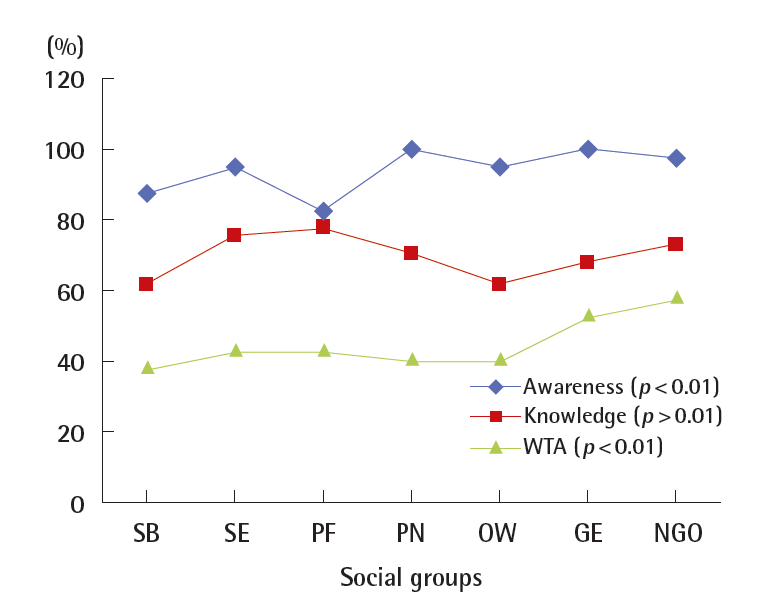
Variations in awareness, knowledge, and willingness-to-act (WTA) levels. SE, students in environmental classes; SB, students in business classes; PF, people living far from incineration facilities; PN, people living near incineration facilities; GE, governmental experts; NGO, non-governmental organization; OW, business-related office worker.
Figure 2 also illustrates that GE and NGO show the higher WTA than the other groups. There is no consistency in patterns between the knowledge curve and the WTA curve.
Figure 3 shows significant differences in the CNS values (p<0.001) and WTA (p<0.01). Occupationally related groups (GE and NGO), PF, and SE show higher CNS values than their counterparts (OW, PN, and SB). It is interesting to note that PN and SE show low and the least CNS values, respectively. It is possible to infer that the CNS values could be somewhat influenced by psycho-social as well as physical environments which one is frequently exposed to.
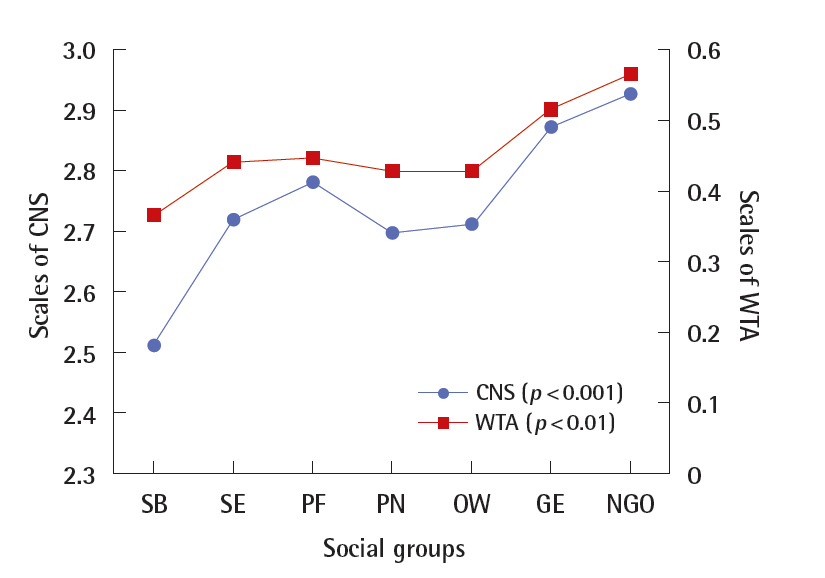
Variations in connectedness-to-nature scale (CNS) and willingness- to-act (WTA) levels. SE, students in environmental classes; SB, students in business classes; PF, people living far from incineration facilities; PN, people living near incineration facilities; GE, governmental experts; NGO, non-governmental organization; OW, business-related office worker.
Figure 3 shows similar patterns between the CNS chart and the WTA chart in frequency distributions: the groups with the highest CNS values (GE and NGO) show the most WTA behaviors, the groups with modest CNS values (PF and SE) show moderate WTA behaviors, and the groups with the lowest CNS values (OW, PN, and SB) show the fewest WTA behaviors.
Figure 4 shows variations in three dimensions of WTA behaviors. There are no significant differences in REDUCE/REUSE and HEALTH behaviors, whereas there are significant differences in CONTRIBUTION behaviors. Governmental experts, NGO, and PN show strong willingness to contribute their time or money. It is necessary to note that PN already participated in an organization, Citizen Watchdog Group. In addition, all respondents relatively prefer REDUCE/REUSE behaviors than HEALTH behaviors, and CONTRIBUTION behaviors are the least preferred by them. It is possible to explore the distribution pattern of behavioral preferences according to the socio-cultural context of groups. For example, one’s smoking habits or dietary behaviors would be related to their choice of HEALTH related risk reduction behavior for reducing dioxin body burden.
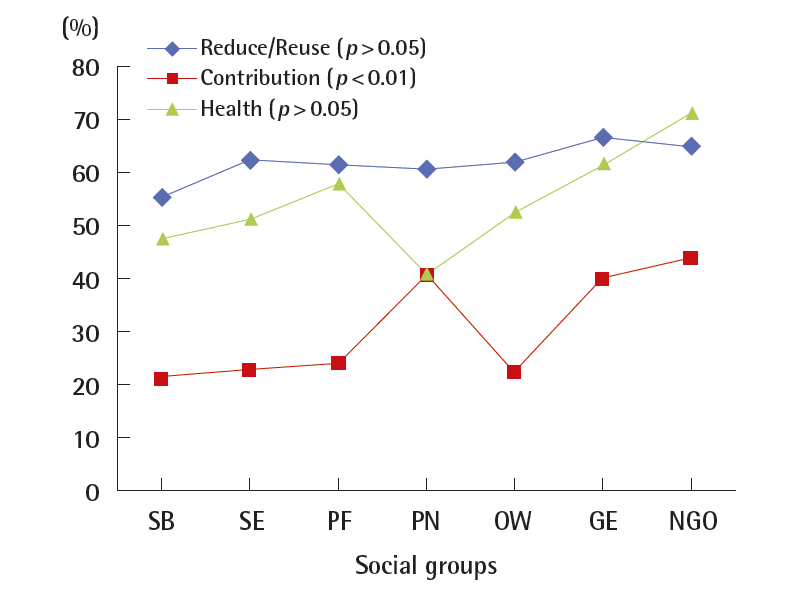
Variations in willingness-to-act behaviors. SB, students in business classes; SE, students in environmental classes; PF, people living far from incineration facilities; PN, people living near incineration facilities; OW, business-related office worker; GE, governmental experts; NGO, nongovernmental organization.
Discussions
The results show that there are variations among social groups in awareness and in behavioral preferences in relation to dioxin risk reduction according to the members’ residential setting, occupational setting, and environmental educational level. In particular, the key result is that the cultural factor examined by one’s feeling of connectedness-to-nature shows significant differences between groups, and again, these cultural variations are related to variations in attitudes and behaviors in response to dioxin risk.
The percentage distributions show that individuals from the groups of PN, GE, NGO, and SE are more aware of dioxin risk than their counterparts (PF, OW, and SB). Particularly, the significance test showed that the residential setting factor is most related to one’s awareness of dioxin risk. Respondents who are aware of the risk show similar levels of knowledge. As for knowledge variation between groups, although it shows no significance, the results indicate that the groups with higher degrees in environmental education and occupation relation (SE, GE, and NGO) showed slightly higher knowledge levels than their counterparts (SB, OW). Therefore, this implies that environmental education and occupation relation factors influence one’s level of knowledge whereas geographic factors do not. This gap may come from the fact that people who are occupationally or educationally involved in the risk are inclined to use a variety of sources of risk information beyond mass media more than people who are not.
There appear to be significant differences in the level of CNS values and in the level of WTA behaviors. The pattern of variations between CNS and WTA are similar; that is, the groups with the highest CNS values show the most WTA behaviors, the groups with modest CNS show moderate WTA, and the groups with the lowest CNS show the fewest WTA behaviors. The relationship between the CNS values and socio-demographic settings appear on the curves. The CNS values seem to be related to occupation association, environmental education relation, and age. Considering that occupationally associated groups (GE and NGO) show a high environmental education level, age is an important factor in relation to CNS values. The two young student groups show lower CNS values and again fewer WTA behaviors than their older counterpart groups (SE<GE and NGO; SB<OW). In addition to the age effect, it is clear that the group studying environmental subjects or majors shows a higher CNS than the group studying business-related subjects or majors. The results imply that one’s selection of occupation and college major may be related to one’s values.
The results seem to show that one’s awareness and knowledge do not affect the level of WTA. The respondents from the lowest awareness group (PF) show a similar level of WTA for risk reduction to the respondents from the highest awareness group (PN). Similarly, the SE show similar awareness and knowledge levels to the respondents from the GE and NGO groups, however, the former show less WTA than the latter. One possible explanation could be that this gap comes from the difference in values between student groups and occupationally related groups.
Socio-demographic settings may affect, to some degree, the selection of preferred WTA behaviors. The results show a significant difference in the selection of CONTRIBUTION, while REDUCE/REUSE and HEALTH are preferred by all groups. The results imply that occupational association is an important factor for the selection of behaviors. In addition, people living near incineration facilities already participated in Citizens’ Watchdog Group. In NGOs that have high numbers of female members, results suggest that gender may affect their behavior since females are more willing to change their dietary behaviors and to purchase organic food. In addition, the income variable has no association with any of the following variables: awareness, knowledge, values, and behaviors.
Overall, the research provides significant implications: 1) one’s social setting is related to variations in one’s awareness, knowledge level, values, and choices of behaviors; 2) one’s geographic setting affects one’s awareness; 3) one’s environmental education and occupation relation has a slight influence on one’s level of knowledge; 4) one’s environmental education and occupation relation is related to one’s CNS values and risk reduction behaviors; 5) CNS is the strongest predictor of WTA behaviors; 6) age is the most important confounding factor that influences variations in CNS and WTA; 7) gender may have a slight influence on one’s choice of behavioral scales whereas income has no relationship with any risk perception variable or behavior.
Culture is an important factor influencing various subjective perceptions of risk as well as one’s choices of risk behaviors. Differences in values or worldview appear among social groups. These cultural variations among groups influence the variations in attitudes and behaviors in response to long-term environmental risk. From the results of this research, it is statistically significant to argue that one’s values particularly explained by one’s connectedness-to-nature not only influence individual behaviors but also group behaviors. From this perspective, we argue that it is necessary to focus on the values of community culture in dealing with complicated global environmental risks. This research could contribute to the areas of value-based environmental risk communication and risk governance. However, it is necessary to undertake further analyses, in-depth interviews and additional surveys in plural experimental settings and with other populations in order to be able to more rigorously verify and generalize the findings.
Notes
The author has no conflicts of interest with the material presented in this paper.
